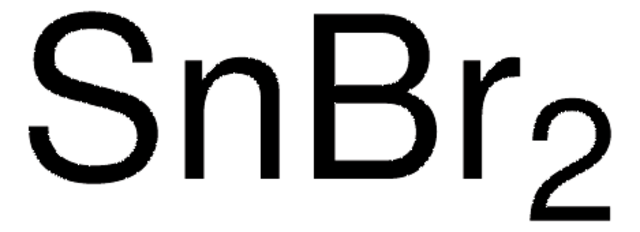203017
Cesium bromide
99.999% trace metals basis
Sinónimos:
Cesium monobromide
About This Item
Productos recomendados
assay
99.999% trace metals basis
form
powder and chunks
impurities
≤15.0 ppm Trace Metal Analysis
mp
636 °C (lit.)
density
4.44 g/mL at 25 °C (lit.)
SMILES string
[Br-].[Cs+]
InChI
1S/BrH.Cs/h1H;/q;+1/p-1
InChI key
LYQFWZFBNBDLEO-UHFFFAOYSA-M
¿Está buscando productos similares? Visita Guía de comparación de productos
Categorías relacionadas
General description
Application
- An electrolyte additives to improve the cycling efficiency of lithium and graphite anodes in lithium-ion batteries. The cesium cations can help control the interfacial chemistry on the anode, leading to enhanced performance.
- An additive to enhance the efficiency and stability of CsPbI2Br perovskite solar cells by passivating defects, improving charge transport properties, and contributing to higher power conversion efficiencies.
- As a precursor material to synthesize cesium lead bromide (CsPbBr3) perovskite, which is then utilized as an electrode material in a symmetric supercapacitor.
- As a precursor to prepare thermal neutron imaging plates.
- As a precursor to synthesize lead-free CsBr: Eu2+ nanocrystals for fabricating white LEDs.
- As an additive to prepare CsI-based scintillators. Alloying with cesium bromide increases the yield limit and microhardness of CsI crystals.
signalword
Warning
hcodes
Hazard Classifications
Acute Tox. 4 Oral - Aquatic Acute 1 - Repr. 2
Storage Class
13 - Non Combustible Solids
wgk_germany
WGK 3
flash_point_f
Not applicable
flash_point_c
Not applicable
ppe
dust mask type N95 (US), Eyeshields, Gloves
Certificados de análisis (COA)
Busque Certificados de análisis (COA) introduciendo el número de lote del producto. Los números de lote se encuentran en la etiqueta del producto después de las palabras «Lot» o «Batch»
¿Ya tiene este producto?
Encuentre la documentación para los productos que ha comprado recientemente en la Biblioteca de documentos.
Los clientes también vieron
Artículos
Colloidal quantum dots (CQDs) are semiconducting crystals of only a few nanometers (ca. 2–12 nm) coated with ligand/surfactant molecules to help prevent agglomeration.
Nuestro equipo de científicos tiene experiencia en todas las áreas de investigación: Ciencias de la vida, Ciencia de los materiales, Síntesis química, Cromatografía, Analítica y muchas otras.
Póngase en contacto con el Servicio técnico












